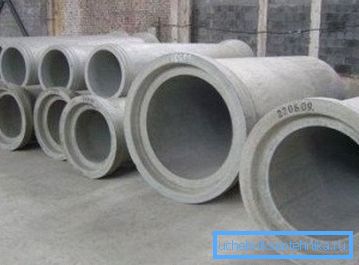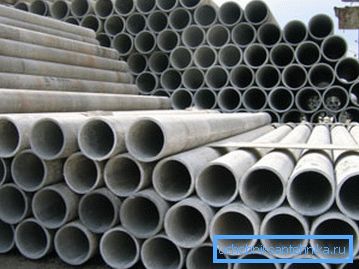Types of sewer pipes: from reinforced concrete to
At installation of systems of water disposal today the most different types of sewer pipes are applied. Each variety, whether it is a traditional cast iron or a modern polymer, has both advantages and disadvantages, as well as installation features that must be taken into account.
Below we analyze the characteristics of products from the most commonly used materials, in addition, we give information about the color marking of pipes for drainage.

Choosing a material
Reinforced concrete
In the analysis of the spectrum of materials used for the manufacture of sewer pipes, in the first place usually referred to as reinforced concrete.
We will not make exceptions, especially since, despite the drawbacks, RC products are still being applied quite actively.
- As a rule, pipes from reinforced concrete are used for external installation of gravity sewer systems by underground method.
- This material is characterized by high chemical resistance, which provides communications with a relatively long service life.
- Depending on the components used in the production, concrete may have different properties. Optimal for the manufacture of tubular products will be solutions of concrete B25 (M350) with a moisture resistance class of at least W6 that can withstand up to 200 freezing cycles.

- Another undoubted advantage of this material is reasonable price. Compared with the arrangement of metal communications savings can reach 35-45%.
However, this material has disadvantages:
- First, a significant mass significantly complicates the installation work. You can hardly do it yourself - you will have to attract a truck crane and a few assistants.
- Secondly, sealing the joints of pipes is very time consuming.
- It should also be noted that, despite the high strength, reinforced concrete does not cope well with shocks, and the risk of chipping and cracking will remain throughout the entire time of pipeline operation.
Asbestos cement
Asbestos-cement products also belong to the budget segment. Such communications are made from concrete, in which ground asbestos, rather than steel, acts as a reinforcing filler. Uniform distribution of the material in the solution provides the pipeline elements with sufficient strength.

In addition, the construction stone obtained during the polymerization of a solution resists tensile well, which makes it possible to use it also in pressure systems.
Note! In this case, special seals are used to seal the joints.
An additional pole is the use of this material in flooded soils: external moisture not only does not reduce the strength of the product, but, on the contrary, contributes to its strengthening due to the hydration of the cement component.
As for the shortcomings, they are:
- Significant weight.
- The difficulty in arranging connections.
- Low impact resistance.

Ceramics
The next item in our list will be products from technological ceramics.
They are produced by molding a mortar based on clay with various additives. The forms filled with raw materials are then subjected to high-temperature processing, as a result of which a durable material is obtained with characteristics ideally suited for use in drainage systems.

Ceramic sewer pipes have such positive qualities:
- First, the material is characterized by the highest chemical resistance. Such varieties are often used in the chemical industry, where aggressive reagents can enter the drains.
- Secondly, the properties of ceramics do not deteriorate over time, so that the laid communications can last up to 100 years or more.
- Products also do not undergo thermal deformations, which does not have a positive effect on the tightness of the joints.
If ceramics is so good, then why didn't it take up the entire market?
The answer lies, of course, in the flaws:
- The main disadvantage is mechanical fragility. A rather awkward movement during unloading, and the product will be hopelessly flawed.
- The short length of the pipes is also inconvenient - for laying it is necessary to use a large number of elements.
- Well, the main drawback is the price. Ceramic varieties are quite expensive, because they are often used by those where other materials simply do not stand up.

Metal
The use of metal products is also quite common. And if steel pipes are gradually becoming obsolete due to their tendency to corrosion, cast iron, as used several centuries ago, is still used today.
The arguments in favor of cast iron are as follows:
- First of all, This material resists oxidation well, which ensures durability of the entire system.
- Secondly, communications are strong enough.
There are material and disadvantages:
- There are a lot of high-quality cast-iron parts, but this is partly compensated by the fact that in life you hardly need to change them.
- The mass of products is quite high, so that the supporting structures will experience a serious load.
- The inner surface is characterized by a significant roughness, which leads to a gradual increase in plaque on the walls and a decrease in the permeability of the system.

And yet, if the walls and ceilings of the house are sustained, and the installation instructions for the joints will be followed very scrupulously, the cast-iron pipes will serve you well for more than a decade.
Polymers

And yet, recently, polymers, primarily polypropylene and polyvinyl chloride, are increasingly used for arranging water disposal systems.
Use in the production of modern chemical compounds provides products with good performance properties:
- First, plastics are chemically inert with respect to most compounds, and therefore they do not corrode.
- Secondly, pipes can withstand considerable pressure (both external and internal), which significantly expands the range of tasks.
Note! Corrugated sewer pipe with a thick wall, made of dense material, for compressive strength is not inferior to cast-iron and ceramic.
- The inner surface of both PVC and polypropylene is practically devoid of irregularities, therefore, communication is much less common.
- The materials absorb sound waves well, because noiseless sewer pipes, which are laid in residential premises, are usually made on the basis of plastic structures with additional sound insulating circuits.
- Finally, the undoubted advantage is a wide range of products. For example, the optimal diameter of a sewer pipe for a sink ranges from 40 to 50 mm, and in this case there are practically no worthy alternatives to polymers. With regard to the variations of a larger section, the situation is somewhat different, but even there it is much easier to choose a plastic model with suitable dimensions.

Color coding
Not less important than the choice of material is the ability to decipher color notation. Having mastered this skill, you will be able to spend less time searching for a suitable pipe.
So what color does that mean?
- Gray sewer pipe is suitable for laying intra-house network. It is made from a material that for a long time retains its properties only indoors.
Note! Where the system is open, and gray plastic will not look quite aesthetically pleasing, white sewer pipes can be used. According to their characteristics, these varieties are similar, and differ only in appearance.
- If you need parts for the exterior of the system, then your choice is a red sewer pipe. Products of red / orange color are more resistant to low temperatures, less susceptible to deformation under loads, etc.

- Black varieties of low-pressure polyethylene are both smooth and corrugated. They are characterized by averaged strength and heat resistance, so you can use them as an additional protection for cables and pipelines.
- For the arrangement of drainage systems used parts painted in green. They well withstand the pressure of a large layer of soil, do not lose strength in the cold, and most importantly - are provided with perforations that allow moisture to enter the pipe cavity.

Of course, to guarantee success, it is imperative to study the labeling of materials and accompanying documentation, but information about the meaning of a particular color will also be very useful.
Conclusion
It is unambiguous to answer which sewer pipes are better, only after a detailed analysis of the whole situation. So the master should “keep in mind” the advantages and disadvantages of all the options, which will make the right choice and successfully accomplish the task with minimum time and cost.
The video in this article contains more information on this topic, therefore we recommend that you read it very carefully.